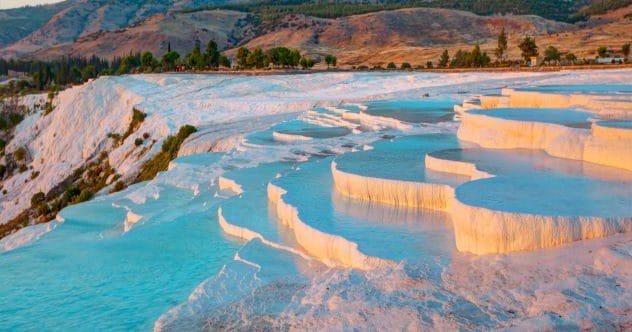We all know about the Grand Canyon, Niagara Falls, and the Great Barrier Reef, but the world is full of lesser-known natural wonders that are just as incredible. These hidden gems offer breathtaking beauty and unique experiences you won’t find anywhere else. Let’s explore ten natural wonders that might just surprise you.
10. Chocolate Hills: The Philippines
Located in the Bohol Province of the Philippines, the Chocolate Hills are a unique geological formation. During the dry season, the grass covering these 1,260 to 1,776 hills turns a distinctive chocolate brown, hence the name. The hills’ formation is believed to be the result of the weathering and erosion of marine limestone over millions of years.
The hills vary in height, with the tallest reaching up to 394 feet (120 meters). While climbing the hills is prohibited, tourists can enjoy the view from an observation platform with 214 steps. The Chocolate Hills are a symbol of the natural attractions in the Bohol Province. [1]
9. Zhangjiajie National Park: China
Found in the Hunan Province of China, Zhangjiajie National Park is a UNESCO World Heritage Site featuring towering sandstone pillars, deep ravines, and unusual peaks. The pillar-rock formations, some rising up to 1,970 feet (600 meters), are the park’s most famous features and even inspired the floating mountains in James Cameron’s Avatar.
Tourists can explore the park through its network of trails, the Bailong Elevator (the tallest outdoor elevator), or by walking across the Zhangjiajie Grand Canyon Glass Bridge—once the world’s longest and tallest glass-bottomed bridge. But be warned, the Glass Bridge isn’t for the faint of heart! [2]
8. Salar De Uyuni: Bolivia
Salar De Uyuni in Bolivia is the world’s largest continuous high-salt desert, covering an area of 4,085 square miles (10,582 square kilometers). After it rains, the salt flat transforms into a giant mirror, reflecting the sky and creating the illusion of walking on clouds.
This unforgettable location is also home to the world’s first salt hotel, the “Palacio De Sal,” built entirely of salt blocks. It serves tourists who travel great distances to witness the unique beauty of Salar De Uyuni. [3]
7. Pamukkale Pools: Turkey
Located in the Denizli Province of southwestern Turkey, Pamukkale, meaning “Cotton Castle,” features white travertine terraces and natural hot springs. The arrangement of these hot springs creates a breathtaking scene in the River Menderes valley.
Visitors can bathe in the pools, walking barefoot from the bottom entrance to the natural hot springs at the top. Pamukkale is also close to the ruins of Hierapolis, making it a diverse and interesting destination. [4]
6. The Wave: United States of America
“The Wave” is a sandstone rock formation in Arizona, near the Utah border, known for its stunning, colorful, and undulating forms. Access is limited to protect its delicate nature, and a daily lottery system selects up to 16 people or four groups to visit.
The best time to visit is during the spring or fall when the weather is mild. Ideal photographs can be captured during the day without shadows or in the early evening with dramatic visuals. [5]
5. Jiuzhaigou Valley: China
The Jiuzhaigou Valley, a UNESCO World Heritage site in Sichuan Province, southwestern China, covers 177,915 acres (72,000 hectares). It features multi-level waterfalls, colorful lakes, and snow-capped peaks.
Jiuzhaigou preserves vital forest ecosystems that provide habitats for threatened plant and animal species. The valley integrates lakes, waterfalls, and limestone terraces with clear, mineral-rich waters set against alpine mountains. [6]
4. Iguazu Falls: Argentina/Brazil Border
Iguazu Falls, located on the Iguazu River on the border of Argentina and Brazil, makes up the most extensive waterfall system in the world. The falls divide the river into the upper and lower Iguazu, surrounded by lush rainforests that amplify the sound of cascading water.
Made up of over 275 waterfalls and cascades this is a spectacular sight. Despite surpassing Niagara Falls in many aspects, Iguazu Falls remains relatively obscure, possibly because the Argentina/Brazil border is less frequented by tourists. [7]
3. Tsingy De Bemaraha: Madagascar
Tsingy De Bemaraha features karstic plateaus with elevated uplands undercut by groundwater, creating caverns and fissures in the limestone. The Malagasy word “Tsingy” means “where one cannot walk barefoot.”
Accessible via wooden walkways and rope bridges over vertical chasms, the park contains rare and threatened animal species. Located in the Antsalova District of Madagascar, it’s considered a center for endemism due to its wealth of unique faunal and floral species. [8]
2. Mount Roraima: Brazil, Guyana, and Venezuela
Mount Roraima, at the junction of Brazil, Guyana, and Venezuela, is a geological marvel with a large, flat surface. The highest point is on the southern edge of the cliff in Venezuela at 9,219 feet (2,810 meters).
Many species on Mount Roraima are unique to the plateau, including diverse forests with orchids, bromeliads, and carnivorous plants. Most tourists approach the mountain from the Venezuelan side. [9]
1. Lake Hillier: Australia
Lake Hillier, a saline lake on Middle Island, is known for its striking pink color, a natural phenomenon. The lake measures about 1,970 feet (600 meters) in length and 820 feet (250 meters) in width, surrounded by a rim of sand and dense woodland.
Discovered in 1802 by Matthew Flinders, it was briefly used as a salt mine and is now a tourism destination. While swimming is prohibited, visitors can enjoy helicopter rides over the lake. Lake Hillier’s pink waters have made it an Instagram-worthy destination. [10]
These ten natural wonders offer just a glimpse of the incredible beauty our planet holds. From the colorful Chocolate Hills to the pink waters of Lake Hillier, each destination provides a unique and unforgettable experience.
Which of these natural wonders sparked your interest the most? Leave your comment below!










